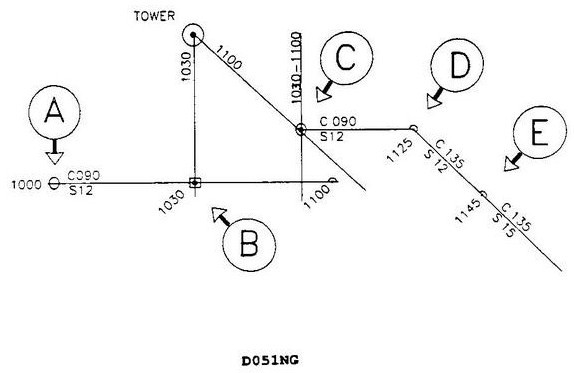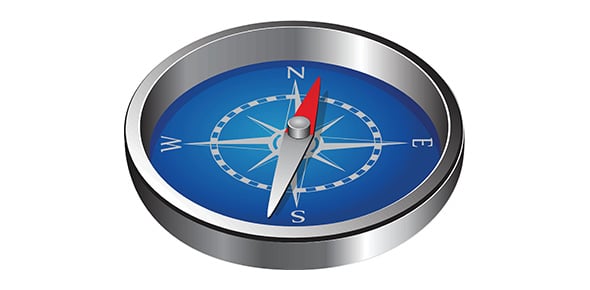Navigation General Practice Exam 1 + Extra Questions Highlighted In Book
-
When does slack water occur?
-
When the current has stopped moving (highest or lowest tide)
-
At spring tide
-

This practice exam, titled 'Navigation General Practice Exam 1 + extra questions highlighted in book', assesses knowledge in maritime navigation. It covers identification of buoys, chart lines, and light characteristics crucial for safe maritime operations.
Quiz Preview
- 2.
If ther'es a fire aboard your vessel, FIRST THING TO DO
-
Sound the alarm
-
Cut off air supply to the fire
-
Have passengers don life preservers
Correct Answer
A. Sound the alarmExplanation
In the event of a fire aboard a vessel, the first thing to do is to sound the alarm. This is crucial as it alerts everyone on board about the emergency and allows them to take immediate action. By sounding the alarm, crew members can initiate the evacuation process, notify passengers and other crew members, and ensure that everyone is aware of the situation. This prompt action increases the chances of a successful evacuation and minimizes the risk to the lives of those on board.Rate this question:
-
- 3.
Yellow buoys mean
-
Dredging
-
Preferred channel
Correct Answer
A. DredgingExplanation
Yellow buoys typically indicate areas where dredging is taking place. Dredging is the process of removing sediment or debris from the bottom of a body of water to maintain or deepen the channel. These buoys serve as markers to alert boaters and ships to the presence of dredging equipment and to navigate around the area. They help ensure safe passage through the preferred channel by indicating the need for caution and avoidance of the dredging operations.Rate this question:
-
- 4.
Which chart is a widely used cylindrical map projection
-
Mercator projection chart
-
Gnomic
-
Polyconic
Correct Answer
A. Mercator projection chartExplanation
The Mercator projection chart is a widely used cylindrical map projection because it preserves straight lines, which makes it useful for navigation purposes. It accurately represents the shape and direction of land masses, but distorts their size at higher latitudes. This projection is commonly used for world maps, especially for navigation charts used by sailors and pilots.Rate this question:
-
- 5.
How do most winds blow in North America? and consequently most weather systems
-
From west to east
-
From north to northwest
Correct Answer
A. From west to eastExplanation
Most winds in North America blow from west to east. This is due to the prevailing westerlies, which are large-scale wind patterns that blow from the west towards the east. These winds are caused by the Earth's rotation and the temperature differences between the equator and the poles. The westerlies play a significant role in shaping weather systems in North America, as they carry weather fronts, storms, and other weather disturbances from west to east across the continent.Rate this question:
-
- 6.
What is a line of position?
-
Line of position is either a bearing line or a radar range, or irregular line
-
None of the above
Correct Answer
A. Line of position is either a bearing line or a radar range, or irregular lineExplanation
A line of position refers to a navigational line that helps determine the position of a vessel or aircraft. It can be either a bearing line, which is a line drawn on a chart representing the direction of a fixed point from the observer's position, or a radar range, which is a line drawn on a radar screen indicating the distance from the observer to a fixed point. It can also be an irregular line, which is a line plotted using a combination of bearings and ranges.Rate this question:
-
- 7.
Monsoon winds reverse direction ________
-
Seasonally
-
Annually
-
Quarterly
Correct Answer
A. SeasonallyExplanation
The monsoon winds reverse direction seasonally. This means that they change their direction periodically, usually on a yearly basis. This reversal of direction is a natural phenomenon that occurs due to the shifting of atmospheric pressure systems and the temperature differences between land and sea. The monsoon winds are vital for the climate and rainfall patterns in many regions, particularly in South and Southeast Asia.Rate this question:
-
- 8.
Where would you expect to encounter trade winds in the North Atlantic
-
5º to 30º North
-
Horse Latitudes
Correct Answer
A. 5º to 30º NorthExplanation
Trade winds are prevailing winds that blow from east to west in the tropics. In the North Atlantic, trade winds are typically encountered between the latitudes of 5º to 30º North. These winds are caused by the rotation of the Earth and the temperature differences between the equator and the poles. They are important for navigation and have historically been used by sailors to facilitate trade routes across the Atlantic Ocean. The Horse Latitudes, on the other hand, are regions of calm and light winds located around 30º North and South, where sailors historically had difficulty due to the lack of wind.Rate this question:
-
- 9.
Occluded front is usually caused by a
-
Cold front overtaking a warm front
-
Warm front dissipating
-
Cold front becoming stationary
Correct Answer
A. Cold front overtaking a warm frontExplanation
An occluded front occurs when a cold front overtakes a warm front. This happens when a cold air mass advances and catches up to a warm air mass, lifting the warm air off the ground. As the warm air rises, it cools and condenses, forming clouds and precipitation. The cold front then overtakes the warm front, creating a boundary where the warm air is completely lifted off the ground. This results in a mix of cold and warm air masses, often leading to unstable weather conditions.Rate this question:
-
- 10.
Name position E
-
Dead reckoning plotted for a speed change
-
Running fix
Correct Answer
A. Dead reckoning plotted for a speed change -
- 11.
Which buoy is NOT numbered
-
Green can buoy
-
Preferred-channel buoy
-
Green gong buoy
-
Red lighted buoy
Correct Answer
A. Preferred-channel buoyExplanation
The preferred-channel buoy is not numbered because it serves as a visual aid to indicate the preferred route for vessels to navigate through a specific channel. It does not require a number since its purpose is to provide guidance rather than identification. On the other hand, the green can buoy, green gong buoy, and red lighted buoy are all numbered as part of the navigational aids system to help mariners identify and locate them accurately.Rate this question:
-
- 12.
SAFE WATER MARK, color
-
Red and white
-
Blue and white
Correct Answer
A. Red and whiteExplanation
blue and white is a MOORING buoy
think candyland when you see red and white. like a peppermint stick in candyland, its easy, safe, wonderful water.Rate this question:
-
- 13.
A new edition is issued
-
When extensive corrections have been made to chart
-
Weekly
-
Annually
-
Bi-annually
Correct Answer
A. When extensive corrections have been made to chartExplanation
A new edition of a chart is issued when extensive corrections have been made to the chart. This implies that the previous edition of the chart had errors or outdated information that needed to be corrected. By issuing a new edition, the corrected and updated information is made available to users. The frequency of issuing new editions may vary, but it typically occurs when significant changes or corrections have been made to the chart.Rate this question:
-
- 14.
Position obtained by taking lines of position from one object at different times and advancing them to a common time is
-
Running Fix
-
Fix
-
Estimated position
-
Dead reckoning
Correct Answer
A. Running FixExplanation
A running fix is obtained by taking lines of position from one object at different times and advancing them to a common time. This allows for a more accurate position to be determined by considering the movement of the object over time. It is different from a fix, which is a single position determined at a specific time, and from dead reckoning, which involves estimating position based on a previously known position and course.Rate this question:
-
- 15.
Advection fog occurs when
-
Warm air from land passes over cold water
-
Cold air from land passes over warm water
Correct Answer
A. Warm air from land passes over cold waterExplanation
Advection fog occurs when warm air from land passes over cold water. As the warm air moves over the cold water, it cools down and reaches its dew point temperature, causing the water vapor in the air to condense into fog. This happens because the cold water cools the air, reducing its ability to hold moisture. The temperature difference between the warm air and cold water is crucial for the formation of advection fog.Rate this question:
-
- 16.
A buoy having red and green horizontal bands would have a light characteristic of
-
Morse "A"
-
Composite group flashing
-
Quick flashing
Correct Answer
A. Composite group flashingExplanation
RED/GREEN = COMPOSITE GROUP FLASHINGRate this question:
-
- 17.
Name the clouds lettered from highest to lowest Name clouds from highest to lowest
-
Cirrus, alto, stratus
-
Altostratus, cirrus, cumulonimbus
Correct Answer
A. Cirrus, alto, stratusExplanation
The correct answer is cirrus, alto, stratus. This is the correct order of clouds from highest to lowest in the Earth's atmosphere. Cirrus clouds are the highest clouds, located at high altitudes and composed of ice crystals. Alto clouds are found at middle altitudes and are often characterized by a layered or wavy appearance. Stratus clouds are the lowest clouds, forming a uniform layer and often associated with overcast skies.Rate this question:
-
- 18.
What type of clouds are layered?
-
Stratus
-
Cumulonimbus
-
Alto
Correct Answer
A. StratusExplanation
Layered clouds are typically referred to as stratus clouds. These clouds form in a uniform, flat, and horizontal shape, appearing like a blanket covering the sky. They often bring overcast conditions and can be found at low altitudes. Stratus clouds are associated with stable atmospheric conditions and usually do not produce significant precipitation.Rate this question:
-
- 19.
How many degrees per point on a compass?
-
11.25º
-
22.5º
-
45º
-
15º
Correct Answer
A. 11.25ºExplanation
Each point on a compass represents 360 degrees divided by the number of points, which is 32. Therefore, to find the number of degrees per point, we divide 360 by 32, which equals 11.25 degrees.Rate this question:
-
- 20.
Unlighted red and green, horizontally banded buoys with the topmost band red
-
Are conical in shape and called nun buoys
-
Are cylindrical in shape and called can buoys
-
Shape has no significance
-
Triangular in shape
Correct Answer
A. Are conical in shape and called nun buoysExplanation
The correct answer is "are conical in shape and called nun buoys". Conical shape and being horizontally banded with the topmost band red are characteristics of nun buoys.Rate this question:
-
- 21.
How to increase range of radar
-
Increase range line
-
Raise antenna height
Correct Answer
A. Raise antenna heightExplanation
Raising the antenna height can help increase the range of a radar system. By elevating the antenna, it has a better line of sight and can detect objects at a greater distance. This is because the higher position allows for a wider coverage area and reduces obstructions that may block the radar signals. Therefore, increasing the height of the antenna is an effective way to extend the range of a radar system.Rate this question:
-
- 22.
Lines on a chart which connect points of equal magnetic variation are called
-
Isogonic lines
-
Magnetic latitudes
-
Dip
-
Variation lines
Correct Answer
A. Isogonic linesExplanation
EQUAL MAGNETIC VARIATION = ISOGONICRate this question:
-
- 23.
SAFE WATER MARK, light signal
-
One short, one prolonged • -
-
One prolonged, one short, one prolonged - • -
-
One prolonged, on short - •
Correct Answer
A. One short, one prolonged • -Explanation
Same as morse code for "OKAY"Rate this question:
-
- 24.
What type of fog forms over land at night?
-
Radiation
-
Advection
-
Smoke
Correct Answer
A. RadiationExplanation
radiation is a body of land getting radiation from surrounding cold waterRate this question:
-
- 25.
On an isomagnetic chart, the line of zero variation is the
-
Agonic line
-
Variation line
-
Zero variation line
-
Isogonic line
Correct Answer
A. Agonic lineExplanation
On an isomagnetic chart, the agonic line represents the line of zero variation. This means that at any point on the agonic line, the magnetic declination is zero, indicating that there is no difference between true north and magnetic north at that location. This line is important for navigation purposes as it helps in determining accurate compass readings and adjusting for magnetic declination.Rate this question:
-
Quiz Review Timeline (Updated): Mar 22, 2023 +
Our quizzes are rigorously reviewed, monitored and continuously updated by our expert board to maintain accuracy, relevance, and timeliness.
-
Current Version
-
Mar 22, 2023Quiz Edited by
ProProfs Editorial Team -
Dec 07, 2011Quiz Created by
Danny5
Competence 2 (Deck)
Competence 2 (Deck) assesses knowledge critical for maritime navigation and safety. It covers signaling in restricted visibility, use of navigation lights, overtaking protocols,...
Questions:
40 |
Attempts:
3839 |
Last updated:
Aug 29, 2023
|
Competence 1 (Deck)
Competence 1 (Deck) assesses knowledge in maritime navigation, focusing on tidal current data, echo sounder operations, magnetic compass adjustments, chart types, and DGPS...
Questions:
40 |
Attempts:
3820 |
Last updated:
Mar 21, 2023
|
3rd Midtern Quiz Dwk 1
This quiz titled '3rd midterm quiz dwk 1' assesses knowledge on maritime navigation and safety, focusing on light and sound signals in various conditions. It is designed to test...
Questions:
30 |
Attempts:
284 |
Last updated:
Mar 20, 2023
|
Nav 1 Prelim A (20 Items)
The 'nav 1 prelim A' quiz assesses skills in maritime navigation, including converting time to arc, determining bearings, and understanding compass readings. It is designed for...
Questions:
20 |
Attempts:
2043 |
Last updated:
Mar 17, 2023
|
Nav 1 Midterm (40 Items)
The 'nav 1 midterm (40 items)' quiz assesses key navigational skills, focusing on ship velocity, chart interpretation, and maritime navigation tools. It is designed for learners...
Questions:
40 |
Attempts:
1297 |
Last updated:
Mar 16, 2023
|
Steering
This quiz titled 'Steering' assesses knowledge in maritime operations, focusing on collision avoidance, emergency procedures, and radar usage as per International Regulations for...
Questions:
60 |
Attempts:
2061 |
Last updated:
Mar 22, 2023
|
 Back to top
Back to top







